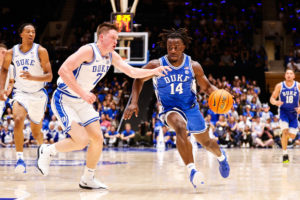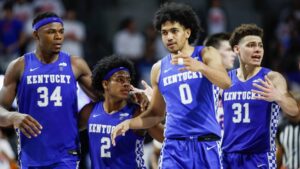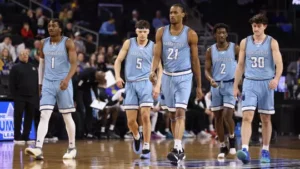
The Golden State Valkyries stamped their authority on Sunday evening at the Chase Center, dismantling the Connecticut Sun by a decisive 87–63 margin. This commanding performance represents their second-largest win of the brief 2025 season and arrives amid a seventh consecutive sellout, signaling explosive interest around this young franchise . Fueled by suffocating defense and a multi-pronged scoring barrage, the Valkyries didn’t merely beat the Sun—they flattened them.
From the outset, Golden State set a tone of intensity. They exploded in the second quarter, engineering a breathtaking 21–3 run that erased any doubt about the game’s direction. That quarter alone yielded 36 points—marking a single-quarter high this season—followed by 59 by halftime. The Sun, meanwhile, were limited to a paltry 35, as Golden State surged into the locker room with a commanding 27-point cushion .
Behind that dominant fortnight was a defense Costa herself would envy. Connecticut ended the night with just 63 points, a victim of relentless pressure, disciplined rotations, and overwhelming rebounding dominance that translated into both defensive stops and fast-break points. With this win, Golden State vaulted to fourth-best in league defensive rating—a significant leap toward head coach Natalie Nakase’s ultimate goal of reaching No. 1.
This performance hinged on disciplined team defense. The Valkyries forced the Sun into rushed decisions, held them to contested jumpers, and logged stop after stop in the lane. Golden State won the rebounding battle 51–35, once again proving how emphatic control of the boards turns games . Behind the scenes, Kayla Thornton—already one of the league’s most disruptive defenders—continues to lead the W over in steals per game (2.3) thanks to her relentless on-ball pestering . The result: those frequent turnovers fueled Valkyries’ secondary scoring and helped fuel their 32 fast-break points and 32 bench points.
Offensively, this game underlined Golden State’s growing depth. Thornton led the way with 21 points and eight boards. Veteran Tiffany Hayes weighed in with 14, while Chloe Bibby, Veronica Burton, and Laeticia Amihere also reached double figures, creating a five-pronged attack that kept Connecticut off balance . A total of 11 players took the court—and all scored—highlighting the flexibility that coach Nakase has engineered amid absences from EuroBasket commitments .
Rookie guard Kaitlyn Chen enjoyed her much-anticipated regular-season debut. Waived in May only to be re-signed mid-June, Chen became the first player of Taiwanese descent to take the floor in a WNBA regular-season game. After making an immediate impact with an and‑1 drive in the second quarter, she finished with five points and a rebound over 21 minutes . Her coach praised her readiness; Chen, in turn, openly admitted to pure excitement when the chance arrived—a signal that the Valkyries see her as a real piece for the future.
Defensively, this wasn’t just about stops—it was quantity, intensity, and control. Connecticut managed only 14 fourth‑quarter points, with the Valkyries phasing in younger reserves once they built an insurmountable lead . Thornton’s elite effort (+31 on the night), Steph Talbot’s season‑high 10 rebounds, and a well‑balanced rotation capped off a complete showing that may serve as a template all season .
On the flip side, the Sun continued a wretched slide. Connecticut has now dropped six straight, rooted to the bottom of the Eastern Conference with a 2–12 record . They managed just one double-figure scorer—Aneesah Morrow’s 14—and repeatedly collapsed under Golden State’s pressure. Inconsistent scoring, disjointed rotations, and weak rebounding have pulled them away from the playoff conversation with no end in sight .
Yet, this loss does more than dent confidence: it casts a spotlight on the structural flaws of a Sun roster in transition. Several core pieces have been underachieving or sidelined, while the coaching staff struggles to find coherent offensive footing. Meanwhile, Golden State has slotted in as the league’s new malefactor—controlling games from end to end.
Beyond individual games, this showdown provided deeper context. As a first-year franchise, the Valkyries are writing history. They’re the first expansion team since 1999 to boast a record above .500 after only 13 games—it currently sits at 7–6 . Their sellout streak at the Chase Center shows a buzz more typical of long-established powerhouses. And perhaps most telling: 17 different players have seen action—more than all but one team this century .
That depth feeds both identity and opportunity. When EuroBasket absences matter, they haven’t faltered—they’ve adapted. Coach Nakase has explored more lineup combinations than any other WNBA team in both minutes and variety, blending veterans with youth, wings with centers, offense with defense . The result is a resilient team with both balance and flair—capable of throttling good teams and grinding through a depleted rotation with equal aplomb.
Kayla Thornton deserves special mention. She’s emerged as the engine of this Valkyries machine—anchoring the defense, sparking comebacks, and now delivering peak efficiency games like Sunday’s. Her season average of 2.3 steals per game dwarfs her previous career high and helps fuel Golden State’s signature transition game . Head coach Nakase has praised Thornton’s disruptive nature as emblematic of the team’s “chaotic but controlled” DNA.
Offensively, the Valkyries have sharpened identity. They’ve embraced an inside-out system, pushing ball movement and spacing around bigs like Amihere who burned Connecticut for 32 paint points . At the same time, they maintain serious transition threat once they force turnovers. Their commitment to sharing responsibilities is clear: a dozen players average double-digit minutes, and more than half have scored in double figures this season .
Looking ahead, Wednesday’s home game against defending champion New York Liberty looms as a definitive test. The Liberty currently sit atop the league with the highest offensive rating—but so do the Valkyries from a defensive standpoint. It’s the moment to confirm whether Golden State can execute their brand of disciplined defense and position-based rebounding against a true contender.
This version of Golden State is far more than an expansion novelty. They’re a running, pressing, rebounding, and sharing team built on identity and energy. This is a collection of players and coaches who believe in hard work, depth, and effort—and so far, it’s produced results well beyond expectations. As of June 23, they’ve built a credible record, a national buzz, and a well-rounded roster. They’ve found identity and begun to impose it on others—with Oklahoma-level force.
That identity extends beyond wins. Last week, Thornton and Hayes used their postgame spotlight to call for fairer player compensation and greater transparency in the next collective bargaining agreement . Their point: as the WNBA evolves—fueled by growing media deals and greater attention—players must reap the benefits. Golden State has provided a megaphone, and its impact may extend far beyond the paint.
Sunday’s win was more than an impressive result—it was a message: the Valkyries are a legitimate threat. Their balanced scoring, deep rotations, strategic defense, and organizational clarity have helped them climb above expectations. It’s now fairly to ask—can an expansion team truly challenge for postseason relevance? At 7–6, Golden State is already playing like one of the league’s best-kept secrets, and they haven’t even hit full strength.
On Wednesday night, they face another measuring stick. If they can stand tall against the Liberty’s barrage, it won’t just validate their season—it’ll prove this is a team built to contend. Either way, one fact stands: after Sunday, the rest of the WNBA must take the Valkyries seriously.





